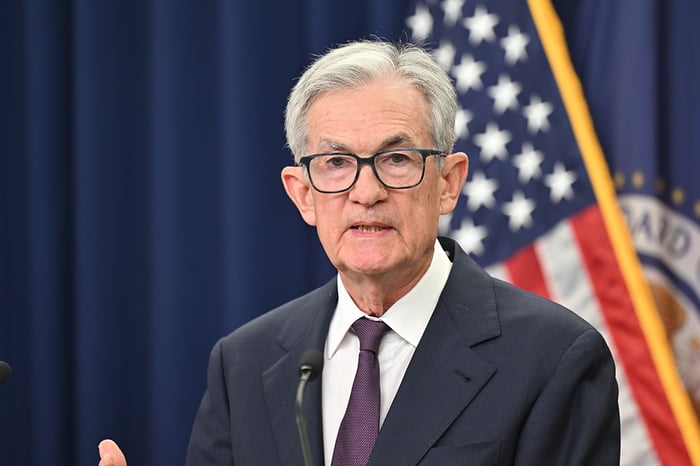Fed Chairman Jerome Powell Just Hinted at a Change That Seems Positive for the Stock Market. But Should Investors Actually Be Worried?
An end to quantitative tightening by the Fed might not be as great for stocks as some think.
When Jerome Powell speaks, markets listen. As well they should. Powell serves as the chair of the Federal Reserve Board. As part of this role, he also leads the Federal Reserve Open Market Committee (FOMC), which sets the monetary policy of the U.S.
Powell recently hinted at a monetary policy change that seems positive for the stock market. But should investors actually be worried?

Federal Reserve Chair Jerome Powell answers reporters’ questions at the FOMC press conference on Sept.17, 2025. Official Federal Reserve Photo.
Good news for investors?
Powell spoke last week at the National Association for Business Economics conference held in Philadelphia, Pennsylvania. One of his key points in his address was an update on the status of the Fed’s “quantitative tightening” approach.
Quantitative tightening is the term used to describe when the Federal Reserve reduces the size of its balance sheet. To accomplish this goal, the Fed allows assets such as government-issued bonds to mature, or it actively sells those assets. This usually results in higher long-term interest rates, lower inflation, and a cooling down of an overheated economy.
The opposite of quantitative tightening is quantitative easing. With this approach, the Fed increases the size of its balance sheet. Quantitative easing is an expansionary policy that’s usually associated with a rising stock market.
In his recent remarks, Powell hinted that the Fed is close to ending its program of quantitative tightening. He said:
Our long-stated plan is to stop balance sheet runoff when reserves are somewhat above the level we judge consistent with ample reserve conditions. We may approach that point in coming months, and we are closely monitoring a wide range of indicators to inform this decision.
Powell always chooses his words deliberately and can often be somewhat ambiguous. However, the takeaway from his comments is that the Fed’s quantitative tightening policies could be almost over. This would seem to be good news for investors.
A more complicated picture
I chose those words deliberately and left room for ambiguity just as Powell likes to do. Why? Because there’s a more complicated picture if the Fed stops its quantitative tightening policies.
For one thing, the end of quantitative tightening doesn’t necessarily mean a return of robust quantitative easing. Some saw quantitative easing as something akin to steroids for the economy and stock market, while quantitative tightening was like a depressant. Using that analogy, discontinuing taking a depressant doesn’t boost strength in the same way as frequently taking a steroid might.
It’s also important to understand that the end of quantitative tightening could be a warning sign about the economy, and by extension, corporate earnings. The Fed doesn’t reduce the size of its balance sheet when the economy is weak. Powell’s remarks, indicating that quantitative tightening could soon taper off, might reflect significant underlying concerns by the Fed about the health of the U.S. economy, despite his seemingly positive statement last week that the economy “may be on a somewhat firmer trajectory than expected.” As the economy goes, so goes the stock market — usually.
Finally, there is a real risk that ending quantitative tightening could backfire. One of the main goals of the policy is to fight inflation. If the Fed returns to expanding its balance sheet, inflation could roar back. The effects of the Trump administration’s tariffs could add fuel to the fire, at least initially. Powell acknowledged in his speech at the National Association for Business Economics conference, “There is no risk-free path for policy as we navigate the tension between our employment and inflation goals.”
The Fed could find itself in a situation where it has to reverse tactics, which would likely create significant uncertainty for the stock market. If there’s anything investors hate, it’s uncertainty.
Should investors worry?
I think celebrating the Fed bringing its quantitative tightening policies to a halt is premature. However, it’s also too soon to worry about the potential impact on stocks from the decision.
We don’t know yet how quickly the Fed will begin increasing the size of its balance sheet. We don’t know how aggressively it will move if and when quantitative tightening comes to an end. We don’t know what else will be happening with the economy or the stock market.
What we do know, though, is that the stock market rises over the long term. Anyone with an investing time horizon measured in decades shouldn’t have anything to worry about, regardless of what the Fed does or doesn’t do in the near term.
The bucket-list bargain city breaks just over an hour from the UK – with cheap eats, £1.25 beers & flights under £40
FANCY a cheeky city break but worried about blowing the Christmas budget?
Fear not, because we’ve rounded up nine of the best bucket-list weekenders, where you can find bargain flights, as well as cheap eats and drinks during the winter months.
Bilbao, Spain
For easily accessible winter warmth on a shoestring budget, Bilbao is a good bet.
This is the Spanish city that is the fastest to reach from the UK, with flights from Bristol taking approximately 1 hour and 45 minutes (and under two hours from London).
It’s also super affordable to reach – one-way Gatwick fares with Vueling Airlines start at just £23 this autumn.
Step off the plane and into double-digit temperatures – the city has highs of 17C in November, ideal for exploring the lush green landscape and Casco Viejo, the picturesque old town with its cobblestone streets and medieval architecture.
Read more on cheap holidays
You can’t visit without indulging in pintxos – the Basque version of tapas – paired with the local tipple Kalimotxo (red wine and cola).
Cheap but highly-rated pintxos bars include local hangout Bar Bacaicoa, known for its griddled mushrooms, £1.13 (€1.30), cod croquettes, £1.50 (€1.70), and spicy chorizo. £1.65 (€1.90).
Beer at a restaurant or pub is also cheaper than in the UK, with a “zurrito” (small glass) of local beer like San Miguel costing around £3.50 (€4).
The world-famous Guggenheim art museum is the city’s main attraction, home to popular works by artists such as Richard Serra, Robert Rauschenberg and Yayoi Kusama.
Although you need a ticket to enter, it’s completely free to admire the outdoor art installations, such as Jeff Koons’s Instagrammable Puppy sculpture guarding the entrance.
Dublin, Ireland
Close to home, Dublin offers a quick city getaway with affordable prices if you know where to look.
Flights from most UK airports are very short, taking just an hour from Manchester and 1 hour 20 minutes from London.
November is the cheapest month to travel to Ireland – return fares to Dublin cost around £36 with Ryanair from the East Midlands and £72 from Heathrow with British Airways.
This leaves extra spending money for its lively pub culture.
The typical price range for a pint of Guinness in city boozers – like O’Donoghue’s, Doheny & Nesbitt’s, Toners and The Baggot Inn – is similar to the UK’s national average of £5.15 (€5.80-€7.00), depending on location.
Tourist hotspots like Temple Bar push prices to £9 (€10.45) for a pint of the black stuff.
Avoid this by heading to a local boozer like The Auld Triangle, where a pint will set you back less than a fiver (€4.95).
You’ll still get traditional live music at a slice of the price.
But there’s much more to Dublin than a giddy Guinness binge.
Take in the city sights, including Phoenix Park and the grounds of Trinity College, both free to explore.
If you’ve got a spare £16 (€18), the Little Museum of Dublin is also well worth a visit.
Set in a cute Georgian townhouse, it’s a quirky one-stop shop for history fans.
Peckish? Wood-fired pizza costs less than £6 (€6.50) from Sano Pizza, while other cheap eats include Brother Hubbard (mezze plates from €7.50) and street food at EatYard, which is open Thursday-Sunday.
Brussels, Belgium
The capital of Belgium is within striking distance of the UK – super affordable flights take just over an hour.
One-way fares this November cost from as little as £33 from Luton with easyJet, with a flight time of 1 hour 20 minutes.
You can find even cheaper flights to the city’s second airport, Charleroi, which is around an hour from the city centre by bus.
The city’s main highlights – including the magnificent Grand Place, Sablon’s Gothic church and the famed Manneken Pis statue – are walkable and free to see.
You can keep costs down by visiting museums on reduced admission days.
For instance, the Royal Museums of Fine Arts of Belgium (normally €10) are free on the first Wednesday of each month from 1pm.
Sample gaufres de Liège (waffles), frites (fries) and Belgian chocolate – but find them at street food stalls, trucks and small cafés for the best price.
Maison Antoine sells a small cone of fries for around £3 (€3.50), while many good chocolate shops give out free samples.
When it comes to beer, avoid tourist trap bars around Grand Place and head to local boozers instead.
Beer Capital has beers from £2.87 (€3.30), and happy hour from noon until midnight, while Cafe Belga is a firm favourite with students.
Amsterdam, The Netherlands
With its quaint canals, treasure-packed museums and vibrant dining scene, Amsterdam is perfect for a European city break.
You can reach this Dutch metropolis in 1 hour and 20 minutes, with easyJet flights from Manchester costing as little as £67 return this winter.
Walking is the best way to see the city’s gorgeous neighbourhoods of Prinsengracht, Herengracht and Keizersgracht, and the trendy Nine Streets area with its independent boutiques.
Planning to see as much as possible? You could save money with the I Amsterdam card, which allows free entry to some museums, including the Van Gogh Museum (but not the Anne Frank House, which you need to book in advance), travel discounts and bicycle rent. A 48-hour card costs £78 (€90).
Grab a £2.61 (€3) beef croquette straight from the wall at FEBO, automated snack machines dotted around the city.
Or head to a street stall to sample Dutch herring with onions and pickles for around €3, or stop by a Stroopwafels stand for freshly made caramel-filled wafers.
Fancy a drink? De Pilsener Club is a cosy, wood-panelled pub and one of the best spots for a cheap beer in the city centre.
Meanwhile, Kriterion is a trendy arthouse cinema with a student bar offering cheap beer (around £4.54 a pint), while Waterhole has happy hour every day (noon-9pm) with beers from £3.48 (€4).
Paris, France
Just 1 hour and 15 minutes from the UK by plane, Paris should make your budget-break bucket list.
While the City of Love has its fair share of overpriced tourist traps, there are ways you can shave euros off the prices you pay.
Avoid eating and drinking around the city’s main attractions, like the Eiffel Tower, Louvre and Arc de Triomphe, where restaurants charge a premium.
Instead, head to neighbourhoods just outside the most central zones (like the 11th, 19th and 20th arrondissements) for cheaper bars and restaurants.
With the average Parisian pint, or ‘pinte’, costing £5.22-£6.96 (€6-8), your best bet for finding budget beer in Paris is to avoid tourist zones and look for happy hour.
The cheapest pint in Paris is reportedly at Chez Marie in the 10th arrondissement – where you can enjoy a pint for £2.18 (€2.50) at happy hour (6-9pm).
When it comes to top-notch food, the French do it well – and crêpes (pancakes) are both filling and good value.
You can find street-side stands selling crêpes or eat them “à emporter” (to go) from around £3.48 (€4).
For lunch on the run, locals grab sandwiches and quiches from boulangeries (bakeries).
Other cheap eats include croque monsieur (ham and cheese toastie), which costs around £6-£8 (€7-9).
Other money-saving tips for Paris include taking the Metro instead of expensive taxis and visiting big museums like the Louvre and Musee d’Orsay on the first Sunday of the month, when they offer free admission.
You can also bag a bargain with flights – easyJet and Vueling offer one-way prices from as little as £24, with Fridays in November and March often offering the best results.
San Sebastian, Spain
In the heart of Spain’s Basque Country, San Sebastian is a foodie’s delight that won’t break the bank.
This city in the north of the country is home to amazing pintxos – tapas-style snacks that are small in price but huge in flavour.
Think olive and pepper skewers, chistorra (AKA smoky sausage), and traditional tortillas – with each dish typically costing less than £4 (around €2-€5).
A pint of beer typically costs around £5 (€5-7) in San Sebastian bars – but you can save money by ordering a smaller ‘caña’ (200ml draft beer), which is usually priced around £2.60 (€3).
British Airways flies direct to San Sebastian from London City, with one-way fares from £120 this autumn.
And with a flight time of 1 hour 55 minutes, you’ll be exploring its golden beaches, lush hillsides and cobbled lanes before you know it.
Even in winter, the weather can be pretty mild, with daytime temperatures rising to around 15 °C in November.
Some of the cheapest pintxos are in the Gros District, a surfing neighbourhood that’s a 10-minute walk from the old town.
The best way to burn the pintxos-hopping calories is to explore on foot.
Walk the scenic promenade along La Concha Bay or hike up Monte Urgull for epic city views that won’t cost you a penny.
Prague, Czech Republic
A couple of hours from the UK by plane, Prague is a firm favourite as a European city break, with cheap food and pints costing a couple of quid.
Even in the centre of the Czech capital, a pint will only set you back around £1.70-2.50 (50-70CZK).
Head further out, and you can expect to pay just £1-1.78 (30-50CZK) for similar drinks.
Hany Bany, a boozer in the city’s old town, sells a small draft beer for just 78p (22CZK) and a pint for £1.25 (35CZK).
Working up an appetite? Grab a plate of hearty goulash and dumplings for £4.20 (119CZK) at Havelská Koruna, which opened as the country’s first fast-food restaurant in 1931.
Located in the old town, it’s a thriving and affordable diner, so arrive by 11.30am to beat the lunchtime crowds.
Save even more on your trip by sampling cheap street food at Havel Market and exploring the grounds of Prague Castle for free.
For a culture fix, some museums have free or cheap entry days, like the National Gallery Prague, which is free to enter on the first Wednesday of the month after 3pm.
In the Old Town Square, you can also watch the Astronomical Clock’s hourly dancing figurine show without spending a single koruna.
Return flights from London to Prague this winter cost from £34 with Ryanair, from £44 with Wizz Air and from £57 with easyJet.
Bordeaux, France
Also under two hours from the UK, the French city of Bordeaux offers cheap wine, local markets and a UNESCO area to discover.
It’s also affordable to reach, with easyJet offering return Bristol flights from £44 this winter.
While a pint of beer will set you back around £6 (€7) in most central bars in Bordeaux, wine is inexpensive.
In Le Bar à Vin Bordeaux, located opposite the tourism office, you can get glasses of decent wine for less than £3 – like a 15cl glass of Bordeaux rose for €2.50.
Meanwhile, you can keep costs low by chowing down street food near Place de la Victoire, or indulging in “canelés”.
These sweet, cylindrical pastries are typically priced less than a euro – La Toque Cuivrée sells them for a mere 60p (€0.70).
When you’ve eaten and drunk your fill, take in the historic centre and 18th-century architecture – a UNESCO World Heritage site.
It won’t cost you a penny to see sights like Place de la Bourse with its beautiful reflecting pool of water.
Later, find souvenirs at the Grands Hommes market or on the rue Sainte Catherine, one of the longest streets in Bordeaux.
If you’re on a tight budget, pick up a steal in Mad Vintage, a second-hand shop, or head to the southern end of the street, which has cheaper, more student-oriented boutiques compared to the higher-end shops of the north.
Munich, Germany
The Bavarian capital is under two hours away, with return Gatwick flights costing from just £59 with easyJet this winter.
Which leaves plenty of spending money once you touch down in this edgy metropolis, which has lakes and mountains on its doorstep and oodles of cultural sights.
Contemporary gallery Museum Brandhorst is a must if you enjoy pop art, and is one of many museums that offer cheap entry for 87p (€1) on Sundays.
Other free must-do activities include watching the famed Glockenspiel show in Marienplatz and strolling around the lush grass and shimmering lake of the English Garden.
Of course, Munich is the beer capital, so it’d be rude not to sample the city’s tipple of choice, Dunkel, which ranks among the best German beers.
A pint of this dark, malty lager is best enjoyed in a noisy beer hall like Augustiner Bräustuben, where it’s £3.35 (€3.85) a pint.
For a cheap bite, make for Viktualienmarkt where you’ll find stalls selling sausage sandwiches for less than £6.09 (€7) or try a bakery for a €1 fresh pretzel.
How to see Dodgers in World Series in person without a ticket
If you crossed “see the Dodgers in the World Series” off your bucket list last year, here’s a bucket list update for you: See the Dodgers in the World Series, from the comfort of a hotel room with a full view of the field.
Not at Dodger Stadium, of course. In Toronto, however, where a hotel is built into the ballpark and 55 rooms allow you to open the curtains and catch the game without a ticket.
During the World Series, the nightly rate for these rooms starts at $3,999 (in Canadian dollars, or about $2,850 in U.S. dollars).
A view of the field from one of the rooms at the Toronto Marriott City Centre.
(Toronto Marriott City Centre.)
That is a lot of money. Then again, the rooms sleep up to five people, and good luck getting five World Series game tickets for that price.
You have to get to Toronto, and that costs a lot of money too. But you don’t need to pay separately for game tickets and a hotel, and you can get room service instead of standing in line at concession stands.
The rooms include chairs that face the field, so you don’t have to stand on your bed to catch the action. And you never know: a player could toss you a ball during batting practice, right through your window. Take a look:
Information and reservations: Toronto Marriott City Centre Hotel.
Sanae Takaichi becomes Japan’s first woman prime minister

Sanae Takaichi (C) acknowledges her fellow lawmakers after being elected as the new prime minister during the general assembly of an extraordinary parliamentary session in Tokyo, Japan, on October 21, 2025. Photo by Franck Robichon/EPA
Oct. 21 (UPI) — Sanae Takaichi was elected prime minister of Japan on Tuesday, becoming the first woman to lead the country.
Japan’s House of Representatives announced in a statement that Takaichi had been “chosen by open ballot” during a plenary session on Tuesday.
Takaichi, the Liberal Democratic Party president, will be Japan’s 104th prime minister. The Japan Times reported that she received 237 votes to Constitutional Democratic Party of Japan leader Yoshihiko Noda‘s 149.
The vote was held after the cabinet of now-former Prime Minister Shigeru Ishiba resigned en masse Tuesday morning.
“To all citizens, I express my deepest gratitude for your understanding and cooperation, and I ask for your continued strong support for the next cabinet and new prime minister as they face domestic and international challenges ahead,” Ishiba said in a statement announcing the end of his coalition government.
Takaichi’s election was made nearly certain after her LDP agreed to form a new coalition government with the Japan Innovation Party on Monday night.
“We will work to realize policies that overcome domestic and international challenges, protect the livelihoods of the people and the peace of the nation and strongly advance Japan forward,” the LDP said Tuesday in a statement.
Ishiba announced his resignation in early September to prevent a split of his LDP following recent election defeats. Takaichi was then made the party leader.
Cranes topple during deadly tornado in northern France | Climate
Video shows towering construction cranes being brought down by a tornado in northern France, where at least one person was killed and several were injured.
Published On 21 Oct 2025
Reparteras: Meet the women of Cuba’s rising urban music scene
Beyond the Cuban diaspora, the genre known as reparto is overwhelmingly unknown. But on the streets of Havana and Hialeah, Miami, reparto is inescapable, pulsing from balconies and portable speakers on the beach.
Born in Cuba’s working-class neighborhoods — known colloquially as repartos — this hyperkinetic fusion of reggaetón, timba and Afro-Cuban rhythms has become the island’s score. In the mid-2000s, artists like Chocolate MC and Elvis Manuel built the genre’s sound on distorted synth stabs, shouted call-and-response hooks, and the distinct Cuban clave beat that makes your body move before your brain can even catch up.
It’s also become a platform for youth navigating scarcity, surveillance and dreams of escaping poverty. The lyrics, characteristically and unapologetically obscene, reflect the realities of life in marginalized communities. But alongside its rhythmic bravado, reparto’s explicit language often veers into the dehumanizing and misogynistic.
The music centers on women, but more often than not, as objects: the perra to conquer, the diabla to tame, the culo to catalog in explicit detail. And it’s no surprise: The genre’s blunt portrayal of women mirrors the machismo deeply embedded in everyday Cuban life.
It’s a refrain you’re bound to hear in any and every nightclub: “¿Donde están las mujeres?” But the next time 10 reparteros link up for a track, they probably won’t call a woman. Within a genre that revolves so heavily around their bodies, women’s voices still remain rare.
So, ¿dónde están las mujeres? Or, where are the women making reparto?

“Chocolate is the king, but who is the queen?” says Seidy Carrera, known artistically as Seidy La Niña. “There’s a space that needs to be filled with women. There’s no f—ing women!”
At the onset of reparto, early reparteras like Melissa and Claudia slipped brief female cameos into club anthems. More than a decade later, due to Cuba’s only recent, and still extremely limited, internet access, these artists and their collaborations have a seemingly untraceable digital footprint. Still, most playlists orbit male voices, and collaborations rarely invite women to the booth: “When reparteros come together on a track, they never call a woman,” she says.
Carrera, 32, was born in the reparto El Cotorro and raised in Miami since she was 6. The self-proclaimed queen of reparto, the paradox defines her career: She fights for space in a scene whose appeal lies in her raw neighborhood realism, but detractors question her authenticity as a gringa, or as they would call her, yuma.
“I feel resistance every day, every single day,” she says. In response, she reclaims the discriminatory language used against her; onstage, she chants “más perra que bonita,” flipping the curse-word from insult to empowerment.
“It’s empowering to say, I’m more perra than pretty. To me, being a perra is being a woman who’s exclusive, who makes her own money. In my case, … nobody opened the door for me, nobody gave me a hand.”
For Havana-based singer-composer Melanie Santiler, 24, the double standard hits her before she can even sing her first note: “I feel that I have to do twice as well. I have to put in double the thought, double the effort, double the talent, always having something more to say,” she says.
“It’s exhausting. It’s exhausting being a woman, having to get up and tell yourself, damn, I have to look pretty and put together. I spent my whole life in school with an onion bun because I didn’t want to do my hair,” Santiler says and laughs, messy bun flopping around her face.
Reaching almost 5 million YouTube views on her 2025 viral collab, “Todo se Supera” with Velito el Bufón, she’s broken into the reparto space as one of the genre’s most distinctive voices. Beside this rise, she’s faced a newfound pressure to dress a way she normally wouldn’t, a beauty standard her masculine counterparts don’t face.

Aliaisys Alvarez Hernández — better known as Ozunaje — says she doesn’t face the same criticism in the urban Cuban music scene, likely due to her sexuality and more masculine appearance. “Reparto is a genre for men, that’s how I see it,” she says. “I dress like a man, I practically live my life like a man, so what I write resembles what men are already saying. That also gave me an impulse, where I feel like more feminine artists, they have to work harder.”
A former rhythmic gymnast from La Habana, Hernández, 23, stumbled into music when friends recorded her singing a demo of “Cosas del Amor” in her living room. Someone uploaded the video, it went viral, and suddenly, she had a career. Since that start, Hernández refuses to only be compared with other reparteras.
Her goal has always been to be measured against men, since “that’s who people actually listen to.” Dressing in traditionally masculine clothing, paired with a deep, raspy delivery, helps her lyrics resonate with locals without the extra hurdle of hyper-sexualized expectations.
Hernández’s androgynous wardrobe and open queerness bring another layer of potential discrimination, but despite the rampant homophobia persistent in present-day Cuba, she doesn’t feel much resistance. “The worst word they throw at me is tortillera, but it doesn’t affect me,” she says, adding, “People like my style, they like that I dress like a guy. Everybody tells me, you have tremendo flow, I love your aguaje, so I haven’t faced any bullying. Never.”

Misogynistic currents in reparto mirror those in early reggaetón, reflecting the average street machismo. The genre’s marginal roots complicate blanket condemnations, since the same raunchy lyrics often encode critiques of class exclusion. Still, reaching bigger stages will require editing the most gratuitous slurs, if only to broaden the music’s export potential. At least, Ozunaje thinks so.
“Reparto came from people who were poor, who had nothing, who were desperate to get out. Nobody imagined it would get this big. Now it’s reaching the whole world, so the vocabulary has to evolve,” she says.
Santiler echoes this critique. “It’s become really repetitive. I think right now, everyone is talking about the same thing. It’s been really easy. Facilista,” she says, using the Spanish term for taking the easy way out. Santiler loves reparto’s swing, but calls most of it objectifying, pointing to Bad Bunny’s “Andrea” and “Neverita,” along with C. Tangana’s “El Madrileño,” as proof that urban music can expand beyond bedroom conquests.
“The street already says these things, and reparto just writes it. It’s an image of what’s happening. But I grew up with other types of music and other types of references, so I’d like to expand beyond that, to make something fresh.”
Santiler adds that the basis of reparto, both in her gratitude and her criticism, comes from pride.
“I love Cuba, I love my country. The current generation of Cuba doesn’t reject their identity — they’re doing the opposite. They want to create a new culture, to create a new movement, and they want the world to know Cuba again,” she says.
American Express Stock Soars — Why It Could Go Even Higher.
A blowout quarter and a premium customer mix are forcing the market to revisit what this franchise is worth.
American Express (AXP 0.70%) is a global payments company with a different model from the card networks most investors know. Unlike Visa and Mastercard, which mainly run transaction networks and avoid lending, American Express issues cards, extends credit, and earns meaningful fee income from premium customers. That difference mattered on Friday, when shares jumped after the company posted strong third-quarter results and lifted its full-year outlook.
Is this move noise or the start of a repricing toward peer-like valuations? I think the latter. With spending and fee income looking good and credit holding steady, it wouldn’t be surprising to see the stock’s valuation multiple expand significantly over time, catching up with the valuation multiples of Visa and Mastercard.

Image source: Getty Images.
Impressive results
It wasn’t surprising to see shares jump following the release of the company’s latest financial results. Third-quarter revenue rose 11% year over year to $18.4 billion, and earnings per share increased 19% to $4.14. Card member spend growth accelerated to 9% (up from 7% growth in Q2). Management also raised full-year guidance, saying it expects 9% to 10% revenue growth and earnings per share of $15.20 to $15.50.
Driving the quarter, the company’s cardmember fee income climbed 18% year over year as more customers adopted its premium cards, which offer travel and lifestyle perks in exchange for annual fees. Additionally, net interest income rose 12%.
Credit metrics look good, too. American Express’s provision for credit losses declined year over year on a lower reserve build. And the company’s net write-off rate held at 1.9%, flat from a year ago and from the prior quarter. For a credit card issuer that keeps credit risk on its own balance sheet, steady write-offs and a lighter reserve build point to disciplined underwriting even as spend grows rapidly.
What makes American Express different
Of course, American Express doesn’t differentiate itself from Visa and Mastercard just by extending credit and charging substantial card fees across its flagship products. The company’s value proposition in the premium space is perhaps the company’s greatest edge. This is fresh on investors’ minds because American Express recently refreshed its U.S. consumer and business Platinum products — and it’s working; new U.S. Platinum account acquisitions in the three weeks following the refresh doubled versus pre-refresh levels, management said in its third-quarter update. Considering that the refresh came with a substantially higher annual fee, that kind of customer response suggests pricing power with the customers who spend the most, use travel benefits, and stay loyal.
Driving home just how premium American Express’s cardmembers are, they spend an average of three times more on their cards than the average spend per card on other networks.
Valuation still trails far behind Visa and Mastercard
Even after the rally, American Express trades at a lower price-to-earnings multiple than the pure networks Visa and Mastercard. The two peers earn higher valuations for their capital-light models, which carry less credit risk and produce steady cash flow. That premium makes sense.
Depending on how you look at it, however, there are also reasons that American Express may deserve a premium. Visa and Mastercard may take on less risk, but American Express participates in more of the profit pool per dollar of spend and has more control over the customer’s overall experience — an advantage that is likely key to helping the company cater to higher spenders.
Ultimately, if American Express can show that its approach is leading to a better customer experience, including higher engagement and greater lifetime customer spend while maintaining good credit metrics, investors may be willing to narrow the gap between American Express’s valuation multiple and its pure network peers.
Of course, being an integrated payments company requires carefully balancing underwriting and incentives to bolster cardmember spending. A surprise rise in delinquencies would pressure earnings. Likewise, a slowdown in the macroeconomic environment could hit discount revenue, customer acquisition trends, and even lending. These factors could keep the valuation discount in place longer than bulls expect.
Still, there’s a lot to like — especially given the stock’s fair price-to-earnings multiple of about 23. This compares to Visa and Mastercard’s price-to-earnings ratios of 34 and 38, respectively. With strong financials in the context of its valuation, American Express stock looks compelling. Revenue is growing at double-digit rates, spend is accelerating, and fee income tied to its premium cards is doing the heavy lifting. Management’s playbook of regularly refreshing its products and deepening engagement while broadening acceptance shows up in the numbers and in guidance.
If American Express’s momentum persists, a narrower valuation gap with Visa and Mastercard makes sense. Friday’s surge looks less like a spike and more like the start of a reset in how investors price this franchise. After years of consistent growth and strong credit metrics, investors might start seeing the company’s integrated payment model as a key competitive advantage worthy of a significantly higher premium.
American Express is an advertising partner of Motley Fool Money. Daniel Sparks and his clients have positions in American Express. The Motley Fool has positions in and recommends Mastercard and Visa. The Motley Fool has a disclosure policy.
Arsenal: How Declan Rice’s role has changed at the Gunners
Arsenal, who host Atletico Madrid in the Champions League on Tuesday (20:00 BST), have changed their style this season to be more direct and play through defensive lines quicker, which has meant Rice moving deeper alongside Zubimendi when starting attacks.
A recruitment specialist working in top level football told BBC Sport how the signing of Zubimendi has complemented Rice’s game.
He said: “It hasn’t changed what he can do as he has done it before, but it [Zubimendi’s arrival] has given him more ability to be an all-rounder.
“He already had the ability to contribute in the holding game but now he is able to excel in attacking phases.
“His ability to take the ball on the half-turn allows his first touch to be always forward when he receives it.
“The attacking role hasn’t phased him. He has grasped it really well and you can tell it’s something he’s always had.”
Rice already has three assists and one goal in his 11 games for Arsenal this season.
For his goal against West Ham, Rice arrived late into the box to meet a bouncing ball and finish well to score Arsenal’s opener in their 2-0 win.
And the recruitment specialist believes Rice, though known for his running ability, does not get the plaudits he deserves.
“A lot of people don’t really give him the credit he is due for his athleticism,” he said. “He is extremely athletic and a good mover.
“He has the freedom to create in the attacking area of the pitch, he is excellent in holding, he is such a fluent player and performs with the freedom he has been given.
“A good player, good passing, but can also be gritty and break up play. He is a commanding midfield player.
“I like the fact that he can dictate the tempo of the game. Really good precision in his actions. He has transitioned seamlessly to a box-to-box player.”
Japan’s parliament confirms hardliner Takaichi as country’s first female PM | Elections News
Appointment clinched via a last-minute coalition deal, but government remains without a majority, leaving the risk of instability.
Published On 21 Oct 2025
Japan’s parliament has elected ultraconservative Sanae Takaichi as the nation’s first female prime minister.
A protege of assassinated former Prime Minister Shinzo Abe, Takaichi received 237 votes in the 465-seat lower house of parliament on Tuesday to confirm her in the role.
Recommended Stories
list of 3 itemsend of list
The victory follows a last-minute coalition deal by her Liberal Democratic Party (LDP) with the right-wing Japan Innovation Party (JIP), also known as Ishin, on Monday. However, her government is still two seats short of a majority, suggesting a risk of instability.
Takaichi replaces Shigeru Ishiba, ending a three-month political vacuum and wrangling since the LDP – which has governed Japan for most of its post-war history – suffered a disastrous election loss in July.
Her victory marks a pivotal moment for a country where men still hold overwhelming sway. But it is also likely to usher in a sharper move to the right on immigration and social issues, with little expectation that it will help to promote gender equality or diversity.
Takaichi has stonewalled measures for women’s advancement. She supports the imperial family’s male-only succession and opposes same-sex marriage and allowing separate surnames for married couples.
The LDP had earlier lost its longtime partner, the Buddhist-backed Komeito, which has a more dovish and centrist stance.
Komeito ended the partnership due to its concerns that the LDP was not prepared to fight corruption.
“Political stability is essential right now,” Takaichi said at the signing ceremony with the JIP leader and Osaka Governor Hirofumi Yoshimura. “Without stability, we cannot push measures for a strong economy or diplomacy.”
JIP will not hold ministerial posts in Takaichi’s Cabinet until his party is confident about its partnership with the LDP, Yoshimura said.
After years of deflation, Japan is now grappling with rising prices, something that has caused public anger and fuelled support for opposition groups, including far-right upstarts.
Like Abe, Takaichi is expected to favour government spending to jumpstart the weakened economy. That has prompted a so-called “Takaichi trade” in the stock market, sending the Nikkei share average to record highs, the most recent on Tuesday.
But it has also caused investor unease about the government’s ability to pay for additional spending in a country where the debt load far outweighs annual output.
Shortly after the lower house vote, Takaichi’s elevation to prime minister was also approved by the less-powerful upper house. She will be sworn in as Japan’s 104th prime minister on Tuesday evening.
Takaichi is also running on a deadline, as she prepares for a major policy speech later this week, talks with United States President Donald Trump and regional summits.
Sarkozy heads to jail over campaign financing
Paul KirbyEurope digital editor and
Hugh Schofieldin Paris
 JULIEN DE ROSA/AFP
JULIEN DE ROSA/AFPNicolas Sarkozy will become the first French ex-president to go to jail, as he starts a five-year sentence for conspiring to fund his election campaign with money from late Libyan dictator Muammar Gaddafi.
Not since World War Two Nazi collaborationist leader Philippe Pétain was jailed for treason in 1945 has any French ex-leader gone behind bars.
Sarkozy, who was president from 2007-2012, has appealed against his jail term at La Santé prison, where he is will occupy a cell roughly measuring 9 sq m (95 sq ft) in the jail’s isolation wing.
More than 100 people stood outside the jail, after his son Louis, 28, called on supporters for a show of support.
Another son, Pierre, called for a message of love – “nothing else, please”.
Nicolas Sarkozy, 70, was due to arrive at 10:00 (08:00 GMT) at the infamous 19th-Century prison in the Montparnasse district south of the River Seine. He continues to protest his innocence in the highly controversial Libyan money affair.
Sarkozy has said he wants no special treatment at the notorious La Santé prison, although he has been put in the isolation section for his own safety as other inmates are notorious drugs dealers or have been convicted for terror offences.
Other than Philippe Pétain, the only other former French head of state to have been jailed was King Louis XVI before his execution in January 1793.
Inside his cell he will have a toilet, shower, desk and small TV. He will be allowed one hour a day for exercise, by himself.
At the end of last week he was received at the Élysée Palace by President Emmanuel Macron, who told reporters on Monday “it was normal that on a human level I should receive one of my predecessors in that context”.
In a further measure of official support for the ex-president, Justice Minister Gérald Darmanin said he would go to visit him in prison as part of his role in ensuring Sarkozy’s safety and the proper functioning of the jail.
“I cannot be insensitive to a man’s distress,” he added.
Ahead of his arrival at La Santé prison, Sarkozy gave a series of media interviews, telling La Tribune: “I’m not afraid of prison. I’ll keep my head held high, including at the prison gates.”
Sarkozy has always denied doing anything wrong in a case involving allegations that his 2007 presidential campaign was funded by millions of euros in Libyan cash.
The former centre-right leader was cleared of personally receiving the money but convicted of criminal association with two close aides, Brice Hortefeux and Claude Guéant, to talk to the Libyans about secret campaign financing.
The two men both had talks with Gadaffi’s intelligence chief and brother-in-law in 2005, in a meeting arranged by a Franco-Lebanese intermediary called Ziad Tiakeddine, who died in Lebanon shortly before Sarkozy’s conviction.
As he lodged an appeal, Sarkozy is still considered innocent but he has been told he must go to jail in view of the “exceptional seriousness of the facts”.
Sarkozy said he would take two books with him into prison, a life of Jesus and the Count of Monte Christo, the story of a man wrongly imprisoned who escapes to wreak vengeance on his prosecutors.
Strictly Come Dancing’s star’s brutal sex ban amid show fears
Strictly Come Dancing contestant Vicky Pattison has confessed to putting a halt on sex with her husband Ercan Ramadan
Strictly Come Dancing star Vicky Pattison has revealed she’s put a stop to bedroom antics with her husband while taking part in the BBC dance competition.
After achieving her best score of the series last weekend, bagging an impressive 29 points with professional partner Kai Widdrington for their spectacular Samba, Vicky and Kai have secured their place in Icons Week.
During a recent episode of the Get A Grip podcast, the 37-year-old confessed she’s steered clear of physical intimacy with her other half since starting on the show.
The frank admission came as Vicky outlined the demanding nature of the programme’s early weeks, explaining: “One minute you’re nervous, you’re messing up your dress rehearsal, you’re getting your period, you’re nearly throwing up behind the scenes because you’re so nervous.”
As Vicky shared her journey, the presenter quickly jumped in with: “Are you pregnant?”, reports Wales Online, reports Wales Online.
But Vicky cheekily responded that her husband hasn’t caught sight of her “lady bits in months”: “No, you’d have to s**g me to get pregnant, mate. Poor Ercan hasn’t seen the sight of my lady bits in months. He’s honestly sick of us.
“I’m like, ‘Well, you’re not getting any now, I’m doing Strictly, mate.'”.
Vicky has also confessed the pressure to start a family has been overwhelming.
Speaking on the Women’s Health Just as Well podcast with Gemma Atkinson and Claire Sanderson, she shared: “My mum told me ‘If not having children is your trajectory, that’s fine,’ which I thought was powerful. I think we’re coming around to the idea as a society that a woman doesn’t have to have children to be fulfilled – and, for me, there’s still a huge question mark over motherhood.
She further added: “I’ve worked to finally get to a place where I’m proud of who I’m becoming, and the thought of taking a break… it scares me.”
Angels’ Mike Trout set to testify in Skaggs wrongful death trial
Angels star Mike Trout is planning to testify Tuesday in a lawsuit over whether the MLB team should be held responsible for the drug overdose death of pitcher Tyler Skaggs.
Trout, a three-time American League most valuable player who hit his 400th career home run this year, is expected to take the stand in a Southern California courtroom and speak about his friendship with Skaggs, who died on a team trip to Texas in 2019 after taking a fentanyl-laced pill he got from Angels communication director Eric Kay. Trout could also be asked about what he knew of Kay’s drug use at the time.
The testimony will come in the trial for a wrongful death lawsuit filed by Skaggs’ wife, Carli, and his parents seeking to hold the Angels’ responsible for his death. The family contends the Angels made a series of reckless decisions that gave Kay access to MLB players when he was addicted to drugs and dealing them; the team has countered that Skaggs was also drinking heavily and his actions occurred on his own time and in the privacy of his hotel room when he died.
During opening statements, a lawyer for the Skaggs family said Trout was aware of Kay’s drug problem and had offered to pay for him to attend rehab. Other players, including former Angels pitcher Wade Miley, who currently plays for the Cincinnati Reds, could also testify during what is expected to be a weeks-long trial in Santa Ana.
The civil case comes more than six years after 27-year-old Skaggs was found dead in the suburban Dallas hotel room where he was staying as the Angels were supposed to open a four-game series against the Texas Rangers. A coroner’s report says Skaggs choked to death on his vomit and that a toxic mix of alcohol, fentanyl and oxycodone was found in his system.
Kay was convicted in 2022 of providing Skaggs with an oxycodone pill laced with fentanyl and sentenced to 22 years in federal prison. His federal criminal trial in Texas included testimony from five MLB players who said they received oxycodone from Kay at various times from 2017 to 2019, the years he was accused of obtaining pills and giving them to Angels players.
Angels outfielder Mike Trout catches a fly ball in front of graphic honoring the life of Tyler Skaggs at Angel Stadium in 2019.
(John McCoy / Getty Images)
The family is seeking $118 million for Skaggs’ lost earnings, compensation for pain and suffering and punitive damages against the team.
Skaggs had been a regular in the Angels’ starting rotation since late 2016 and struggled with injuries repeatedly during that time. He previously played for the Arizona Diamondbacks.
After Skaggs’ death, the MLB reached a deal with the players association to start testing for opioids and to refer those who test positive to the treatment board.
Taxin writes for the Associated Press.
Trump deploys Coast Guard to Rio Grande in new immigration operation

The Trump administration on Monday announced the launch of Operation River Wall, a surge of Coast Guard personnel to the Rio Grande River to curb drugs trafficking and illegal immigration. File Photo by Adam Davis/EPA-EFE
Oct. 21 (UPI) — The Trump administration is surging U.S. Coast Guard resources to the Rio Grande River to prevent migrants and drugs from making their way from Mexico across the body of water into Texas.
Since his inauguration in January, President Donald Trump has been seeking to seal off the U.S.-Mexico border as part of his immigration crackdown.
Homeland Security Secretary Kristi Noem announced Operation River Wall in a statement Monday, calling it an “unprecedented mobilization” of Coast Guard boats, shallow watercraft, tactical teams and command and control assets to the Rio Grande in eastern Texas.
The exact number of resources deployed was not made public, though DHS said the operation is “beginning” with more than 100 boats and hundreds of personnel.
According to a statement from the Coast Guard, it has been deploying resources to the Rio Grande since Oct. 9 with the mission to “ensure operational control of the border” where Trump declared a national emergency on his first day in office.
That declaration, stating that the United States is “under attack” and experiencing an “invasion” via its southern border, has faced and continues to face legal challenges, particularly over its scope and the powers it affords the president.
“President Trump delivered the most secure southern border in U.S. history in record time, and now, our goal is to make sure it stays that way for the long run,” Noem said.
“Now, Coast Guard Forces Rio Grande and Operation River Wall will be a force multiplier in defending against illegal immigration.”
Venezuela’s Supersonic Anti-Ship Missiles Are A Real Threat To American Warships
American warships operating off Venezuela’s coast are not doing so without a credible threat. This comes from the presence of the Russian-made Kh-31 high-speed air-to-surface missile. Known to NATO as the AS-17 Krypton, the ramjet-powered weapon is available in both anti-radiation and anti-ship versions, with the ship-killer being the most relevant in this context. With this reality, combined with the steady drumbeat of reports raising the prospect of a military intervention of some kind in Venezuela, it’s worth looking closer at this unique capability within its arsenal.
While we have previously discussed in detail the different layers of Venezuela’s air defense system, it’s one of the key assets of its air force, the Aviación Militar Bolivariana Venezolana, AMBV, or Bolivarian Venezuelan Military Aviation, that is the launch platform for its Kh-31s. This is the Su-30MK2V Flanker multirole fighter, 24 of which were delivered between 2006 and 2008, and 21 of which survive in service today.


It should be noted that it’s not entirely clear whether Venezuela received both the anti-radiation Kh-31P and the anti-ship Kh-31A to arm its Su-30s. However, the Kh-31A, at least, appears to have been supplied, as seen in official videos showing AMBV Su-30s carrying the missiles while flying off the coast of Venezuela. Most recently, this kind of footage has been distributed by Caracas in an apparent statement of resolve against potential U.S. aggression. Venezuela has publicized its anti-ship quick reaction alert drills with these missiles in the past, as well. Moreover, the Kh-31P could also be used in anti-ship capacity, homing in on warships’ radars.
A video shows Venezuelan Su-30s using Kh-31s to launch a mock attack on a ship from an alert posture:

The development of the Kh-31 series of missiles began in the late 1970s in what was then the Soviet Union. The original requirement was for a high-speed anti-radiation missile that would be able to home in on and destroy the radars associated with then-new and emerging western air defense systems, such as the U.S. Army’s Patriot surface-to-air missile system and the U.S. Navy’s Aegis combat system.
The Kh-31A anti-ship missile entered production in 1990. Outside of Russia, it has proven an export success, with around a dozen operators, including China, India, and Vietnam.

Looking at the Kh-31A in more detail, it is fitted with an active radar seeker with a lock-on range of around 18 miles. The seeker works in both lock-on before and lock-on after launch modes. The missile also has a radio altimeter to ensure it can fly precisely at low altitude flight over water. All Kh-31s use a rocket-ramjet propulsion system to achieve sustained supersonic speeds. A rocket in the rear of the weapon boosts it to an optimal speed for the air-breathing ramjet to take over.
Combined with its high terminal speed, the Kh-31A has a penetration warhead, designed to punch through the side of a warship and detonate. This is in contrast to the high-explosive/fragmentation warhead in the Kh-31P. Making the missile harder to defeat is its ability to perform multi-axis maneuvers at up to 15G while skimming over the waves.

In terms of performance, the Kh-31A has a maximum range of 31 miles and a minimum launch distance of 9.3 miles. A longer-range version, the Kh-31AD, exists, with a maximum range of 75-100 miles, but it’s unclear if this was ever supplied to Venezuela.
The missile is accelerated to a speed of Mach 1.8 by means of a solid-propellant rocket booster; when the solid fuel is expended, the engine is ejected and the inside of the missile body is transformed into a combustion chamber for the ramjet, which accelerates the missile to Mach 3.5 at an altitude of 53,000 feet, or Mach 1.8 at sea level.

Each round weighs 1,323 pounds at launch, of which 192 pounds consists of the warhead. The Kh-31A is a notably big missile, with a total length of 15 feet 5 inches.
A good indicator of just how seriously the U.S. Navy takes the threat posed by the Kh-31A can be seen in its decision to buy the missiles from Russia and repurpose them as anti-ship missile targets to test the air defenses of its warships. The resulting target missile was known as the MA-31 and is a topic that we have written about in depth in the past.


Today, the Kh-31A may be old technology and also a weapon that the U.S. Navy has had first-hand experience of defeating (albeit in non-operational scenarios), however, its potency as an anti-ship weapon shouldn’t be underestimated.



This is true especially considering the variety of U.S. naval assets now sailing in relatively close proximity to Venezuela, in an operation aimed at putting pressure on Venezuelan President Nicolás Maduro. The Kh-31A is a threat to be taken seriously.
The U.S. naval presence in the region includes the Iwo Jima Amphibious Readiness Group (ARG)/22nd Marine Expeditionary Unit (MEU), with more than 4,500 sailors and Marines on three ships: The Wasp class amphibious assault ship, the USS Iwo Jima, and the San Antonio class amphibious transport dock ships, the USS San Antonio and USS Fort Lauderdale.
Also deployed in the region are several Arleigh Burke class guided missile destroyers, a Ticonderoga class guided missile cruiser, and the Ocean Trader, a shadowy special operations mothership. The presence of a cruiser, in particular, shadowing the Ocean Trader, underscores the fact that the Pentagon is taking the threat to this vessel very seriously. After all, the Ocean Trader has no organic defenses against anti-ship missiles and has, at times, operated very close to the Venezuelan coast.
As for the Arleigh Burkes, it is worth recalling that the Navy has already made efforts to bolster the defenses of some of these. Those that are forward-deployed to Rota, Spain, feature specific kinetic and non-kinetic systems to operate in the face of anti-ship cruise missiles in high-threat areas, including off the coast of Syria, but also in the Black Sea, which is a nearly land-locked super anti-ship missile engagement zone. Other electronic warfare upgrades continue on various surface combatants across the fleet, including some that are radical in scope.
While these ships are capable of dealing with Kh-31s, and the Navy has learned a lot when it comes to defending against complex attacks on their ships over the last couple of years, that doesn’t mean they can ignore them. Its speed leaves very little reaction time, especially considering early warning would be limited if the vessels were operating very close to the Venezuelan coastline.
Exactly what the U.S. plans to do with its military assets in regard to Maduro remains unclear. Back in August, as the military buildup gathered pace, U.S. officials told CNN that it had ordered naval movements in the region to contain the threat from drug-trafficking groups.
As we have outlined in the past, the deployment of an ARG and various surface combatants, as well as other high-end assets, sends a very strong signal to Maduro and the cartels. The Pentagon could carry out airstrikes or even put a limited number of boots on the ground from international waters in a hurry via special operations raids should President Donald Trump so decide. These may be aimed at cartels linked to Maduro and not the regime itself, but they still would be unprecedented.

Were such a military option to be launched, it would be possible that Venezuela’s Su-30s, armed with Kh-31A missiles, would be called into action, although targeting a U.S. Navy warship would be a huge deal, with massive repercussions.
In recent weeks, however, Venezuela has flown its fighters directly at U.S. warships, a Pentagon official having confirmed to TWZ that a pair of Venezuelan F-16s flew close to a U.S. Navy vessel in September, as you can read about here. Other similar instances have reportedly occurred. With U.S. Navy vessels operating close to the Venezuelan coast, there exists the very real possibility of a surprise attack on these ships as these close encounters would have put fighter aircraft within the Kh-31’s launch range.
Aside from the Su-30/Kh-31 combination, Venezuela’s anti-ship missile capabilities are currently fairly limited.
The Venezuelan Navy has a single operational Mariscal Sucre class frigate, the Almirante Brión, part of a group of warships that were commissioned in the early 1980s. The Italian-made warship was supplied armed with eight launchers for Otomat Mk 2 anti-ship missiles. The same missiles, in twin launchers, were fitted to the Venezeulan Navy’s Constitución class fast attack craft, of which three are reportedly still operational.

Italy also supplied Venezuela with Sea Killer anti-ship missiles, which armed Venezuelan Navy AB.212 helicopters, several of which remain active, although primarily now used for assault and logistics missions.
The operational status of these Italian-made systems should be considered questionable. Even if still serviceable, they are a far less threatening proposition than the Kh-31A. Both missiles have subsonic performance. The Otomat Mk 2 has a range of around 110 miles, while the Sea Killer can hit targets out to a range of around 6.2 miles.
More recent anti-ship missile deliveries comprise the Iranian-made CM-90 (an export version of the Nasr) that were supplied by Tehran along with Peykaap III (Zolfaghar class) fast attack craft. These are also subsonic weapons.
Although the U.S. Navy is now much more familiar with the threat posed by the AS-17 Krypton, and while its warships are fitted with air defense systems that are capable of dealing with just such a threat, among others, this remains a very potent weapon.
If Venezuela were to directly attack an American warship, it would very likely result in being at war with the United States. But if the regime was already in such a predicament, or if it was facing imminent collapse, such an act could become a greater possibility.
Contact the author: [email protected]
What went wrong for Sarah Jayne Dunn? Pals reveal soap star’s pain as friends and TV bosses shun her after X-rated pics
SHE was famously axed from one of the country’s biggest soaps after joining OnlyFans – and within weeks was among its top creators, earning hundreds of thousands from her racy snaps.
But Sarah Jayne Dunn‘s X-rated spark has fizzled out, according to pals who say the former Hollyoaks star – who faced accusations she was promoting “pornography” last week – has been left out in the cold. Now, The Sun can reveal things have gone from bad to worse.
An insider told us: “There was a lot of fanfare when Sarah left the soap, and she made a big thing about why it was important to be on OnlyFans.
“It might look plain sailing, but it’s a real slog and actually very isolating. She knows people look at her at the school gates, and you only have to look online to see people’s disgust about what she does.”
Sarah, 44, has raked in some serious cash since she was sacked from Hollyoaks in 2021 after joining OnlyFans.
It’s a bit of a rabbit hole once you get started and pals are worried how far it will go
She made a whopping £121,000 in just 48 hours after her OnlyFans subscribers doubled overnight when she went public about her new career.
Fans pay just over £11 per month to see Sarah strip off, and her posts have been liked more than 455,000 times since she joined the site four years ago this month. Her subscription numbers are no longer visible to fans.
But as the months have worn on, Sarah has had to deal with lewd, vulgar and creepy comments from her desperate subscribers, who constantly plead with her to flash more flesh.
In the last two weeks alone, her OnlyFans snaps have been littered with explicit remarks, piling on the pressure for even racier content – raising questions about what Sarah’s future on the site will look like.
Our insider continued: “Subscribers have naturally gone down, so Sarah has been working hard to produce more and more racy content. It’s a bit of a rabbit hole once you get started, and those who are still close to her are worried about how far it will go.
“Her son is getting older now, and it can’t be easy for him seeing her pictures and the headlines.”
Sarah has a nine-year-old son, Stanley, with her personal trainer husband, Jonathan Smith.
While she has previously shared a picture of Stan taking over her £20k pole-dancing room, which she had built in her garden, to play his video games, the ex-Oaks star tries to be careful around the youngster when it comes to her day job – because he is becoming “really inquisitive”.
She said last month: “He’s getting to that age where he’s really inquisitive about everything.
“I was sat in the bedroom the other morning doing my make-up, and he comes into the bedroom and goes, ‘Mum, what is p***y?’ I was racking my brain, going, ‘Oh my God, what has he seen?’ I’ve got this book next to my make-up mirror called P***y.”
Sarah – who played Hollyoaks’ Mandy Richardson from 1996 to 2021 – has made no secret of wanting to maintain her wealth and has recently trained as a pole dancing teacher to boost her income.
But she was left embarrassed and fuming after her fitness pole dancing class was banned by a Cheshire venue last week and labelled “borderline pornographic”.
It was the latest blow for the star who has struggled to land TV work and has lost two of her closest friends in her bid to become a top content creator.
Showbiz bust-up
We can reveal she is no longer speaking to Stephanie Waring, who played her onscreen sister, following her fallout with glamour model Rhian Sugden.
Raised eyebrows over her lifestyle choice is not something new for Sarah, who recently admitted she has constantly faced accusations she is baring all on OnlyFans.
She recently said: “Whenever I get stick, it’s because of people going, ‘Well, you’re getting your fl**s out,’ and I’m like, ‘I’m actually not, thank you very much.’
“People just associate the platform with porn. That’s fine, because the platform does have that content, but it doesn’t mean everyone on there is doing that.”
Hollyoaks bosses clearly had a similar view, and we can reveal that since joining OnlyFans, Sarah has had a bust-up with her former co-star Stephanie Waring.
An insider told us: “Sarah and Steph were always very close, but when Sarah started posting online, things between them started to change.
“They have barely spoken since, and Sarah definitely didn’t rush to support her when she was axed from the show last year.
“They don’t even follow each other anymore. It’s very sad it’s come to this.”
Steph has previously said she wouldn’t dream of using her body to make money – unlike Sarah.
Sarah is convinced Steph is one of the people who grassed her up to Hollyoaks bosses
An Insider
She told the Secure The Insecure podcast: “I don’t think I could ever sexualise myself in that way.
“I’m nearly 50 and I just don’t think that’s my angle… never say never, though. People change all the time.”
One of Sarah’s post-Hollyoaks ventures saw her co-host podcast Hot and Bothered alongside Page 3 legend Rhian Sugden, in which the pair discussed everything from sex toys to fetishes.
Sarah and Rhian even took part in a joint lingerie-clad photoshoot to promote their sex podcast – but the pair have since fallen out.
Rhian claimed she had been dropped from the joint podcast, despite reportedly investing thousands in it, and the pair are no longer thought to be on speaking terms.
In 2023, a friend close to the pair said: “Rhian reached out to Sarah after the whole Hollyoaks sacking drama, and she became a real source of support for her.
“They went in on the podcast together and had loads of fun making it – and had loads of listeners.
“It came as a real shock to everyone when Sarah just cut her out. There’s been no contact since, and it’s all very sad.”
Big show dreams
Sarah has also been left hanging by I’m A Celebrity… Get Me Out Of Here! and Strictly Come Dancing bosses.
Last weekend, she made it clear to her OnlyFans followers how much she wants to land a spot on her dream show – Strictly.
She posted a picture wearing a see-through red bra with sequins, with her nipples clearly visible, and asked her followers: “Who’d like to see me on Strictly?!”
Sarah received just one response. The follower wrote: “People would [black love heart emoji] to see you on Strictly!”
The star also has her heart set on appearing in I’m A Celebrity, which is filmed in the Australian jungle.
A source told us: “Sarah has made no secret of the fact she would love to head into the jungle, or on the Strictly ballroom, but neither shows have come calling yet.
“They are dream paydays for most out-of-work actors and content creators, and she is desperate to appear on one.”
Another pal close to Sarah insisted: “Sarah is under no pressure around her OnlyFans work, she is able to be fully in control of her life, work as and when she wants, and it’s afforded her numerous wonderful opportunities.
“With regards to any mention of a fall out with friends, there is certainly no falling out from Sarah’s side, so this is news to her. Sarah is a huge fan of Strictly Come Dancing, so naturally would love to be on the show!”
It doesn’t look like BBC bosses will be calling her to swap pole dancing for the ballroom just yet, so for now, Sarah may have to stick to the sexy snaps.
A taste of north Wales: a walk between cafes (and pubs) on the Llŷn peninsula | Wales holidays
In all human endeavours undertaken within Britiain’s isles, the provision of tea and cake is the most vital consideration. When a walker or cyclist delivers the damning judgment “there’s no decent caff” to a group of friends, the ghastly silence is followed by everyone crossing the accursed region off their map. The sheer importance of this staple dietary ingredient is obvious from our island geography: Dundee, Eccles, Bakewell, Chelsea …
So it was with some trepidation that I set out to walk around the Llŷn peninsula in Gwynedd, Wales, on part of what is called the Seafood Trail. I mean, I love a lobster, but what about the fruit scones? Bangor University’s school of ocean sciences has produced a map of seafood producers and outlets to encourage hikers as they stride along the coastal path. Fine, but it’s the late afternoon sugar lull that I worry about.
We start on the north coast in Nefyn, a place that boasts an excellent brewery and a good beach with one of the most Instagrammed pubs in Wales, the Tŷ Coch Inn. Me and my friend Andy are both nervously scanning the weather apps as the forecast is stormy. The plan is to walk and camp, but only after a gentle start in the Nanhoron Arms hotel. This proves doubly beneficial as the dinner includes a delicious Anglesey sea bass and, next morning, we can stay dry while watching a barrage of lashing rain come down. We have each brought a tent, but neither item has been tested at this level of downpour.
I am already a convert to the Welsh Coast Path, one of the finest walks in the world, but I have never done this particular section. Immediately, we are off to a great start: the rain stops and we cross Nefyn golf ccourse and settle into a rhythm of cliff and cove. In one sheltered spot, a few Atlantic grey seals play in the shallows while the older ones snooze on the beach. A kestrel hovers overhead and butterflies skip around a few late flowers. In May this would be a floral bonanza, but now we have blackberries to keep us going.
Then, with lunchtime approaching, we start scanning ahead and almost immediately we see Cwt Tatws. The translation is roughly the Potato Shed but the name belies the true magnificence of this cafe, all the more splendid for its ideal location close to a beautiful stretch of sandy beach in Towyn. A rich selection of sandwiches, salads, pies and, of course, cakes, is augmented by cosy seating, a vintage clothing section and a range of Welsh products. Neither of us, unfortunately, has space in our rucksacks for a sack of sea salt or a bottle of Welsh whisky. However, we do manage an extra slice of coffee and walnut sponge before heading off.
After 3 miles (5km), we drop down on to a sandy beach at low tide and weave through a set of sentinel rocks. This long lovely stretch, Traeth Penllech, is a real gem, leading us up to the first campsite at Moel-y-Berth. Run by Mike and Joanna Smith, this is the kind of place people return to every year. There is a shop and a handy cafe for breakfast where, the next morning, we sit and watch another rampaging storm come blasting through. When we emerge, however, the sun is out again.
Our luck holds all day, but by midafternoon a crisis is looming. Without tea and cake, I reckon, I’ve only got a few miles left in my legs. But then at Porthor’s Whistling Sands beach, Caffi Porthor pops up, another gem, serving a vast range of delicious homemade cakes, including a Welsh stalwart, Bara brith. If you’re not familiar with this heavenly manna, it’s a fruit cake made with tea and spices. And Caffi Porthor makes the best I’ve ever tasted. Andy, foolishly, turns it down and the result, three miles later, is that he runs out of steam, taking a short cut across the headland to Dwyros, our second campsite. Meanwhile, powered by tea and cake, I stride on for a further seven miles around what is the best section so far: the actual tip of the Llŷn peninsula. The spectacular cliffs offer a fine view of the tidal race between the headland and Bardsey Island. On a day like this one, when the wind is gusting powerfully and the current is running at about four metres per second, it’s a fearsome sight.
Aberdaron, just around the corner, is a lovely village with an excellent fish and chip shop, Sblash, and a fine pub, The Ship, a good spot to try out a few words of Welsh as that’s the main language here, as on most of the Llyn.
after newsletter promotion
Unfortunately, the following morning my own language skills fail. When I ask some teenage boys for the path to Rhiw, the next village, I’m met with sniggers. Apparently I’m asking for sex.
The seafood, however, has really kicked in now. At Rhiw I meet Brett and Nia who harvest crab and lobster for their Top Cat Caffi where we eat a lobster salad lunch. However, the weather is deteriorating fast so we can’t get out to help with the day’s catch, something Brett encourages visitors to do. That evening, camped at Rhydolion farm, we stagger an extra mile to the pretty inland village of Llanengan and eat bowls of delicious mussels at the Sun Inn.
The final day is a bracing stomp across surfers’ beach, Hell’s Mouth, a notorious shipwreck spot in the past, then around Mynydd Cilan headland to Abersoch where there’s plenty of cafes to hide from the storm. The seafood has been great, but it’s the memories of tea and cakes that I will treasure.
The trip was provided by Natural Resources Wales
2025 BBC Women's Footballer of the Year contenders
Meet the five contenders who have been nominated for the 2025 BBC Women’s Footballer of the Year award.
Source link
Myanmar military arrests more than 2,000 people at infamous scam centre | Crime News
The military also confiscated 30 Starlink satellites from the sprawling KK Park scam centre on the border with Thailand.
Published On 21 Oct 2025
Myanmar’s military says it has arrested more than 2,000 people in a raid on KK Park, an infamous scam centre on the border with Thailand, according to state media.
The sprawling compound was used by international criminal syndicates to carry out illegal gambling, money laundering, and online romance and investment scams, the Myanmar Alin daily reported on Monday.
Recommended Stories
list of 4 itemsend of list
Operations were spread across more than 250 low-rise buildings, according to the media report. They included warehouses, shophouses, and dozens of one and two-storey buildings.
During the raid, the military also seized 30 Starlink satellites, Myanmar Alin said.
The satellites are built and run by Starlink, a subsidiary of Elon Musk’s SpaceX, and can keep compounds connected to the internet, even during power cuts.
Authorities also arrested 2,198 people, among them 445 women, 1,645 men and 98 male security guards, although the newspaper did not list their nationalities.
KK Park is located in Kayin State’s Myawaddy Township, which lies just across the river from the Thai border town of Mae Sot.

The area has seen recent fighting between Myanmar’s military, the People’s Defence Force – the armed wing of Myanmar’s National Unity Government, formed by elected lawmakers, which operates from exile after it was ousted in the 2021 military coup – and armed Karen ethnic groups, according to Myanmar Alin.
Myanmar has been embroiled in a civil war since the coup in 2021, with fighting between the military, armed opposition groups and ethnic armies.
Military spokesperson Major-General Zaw Min Tun said on Monday in a statement that the top leaders of the Karen National Union, one of the groups fighting the military, were involved in the scam projects at KK Park, according to the Associated Press news agency.
Myanmar has been under pressure from Thailand and China to curb scam centre activity, which has drawn in criminal groups, particularly Chinese crime syndicates.
The issue became a cause célèbre in China in January when Chinese actor Wang Xing was trafficked to a scam centre and later rescued by Thai police.
Employees of the scam centres are often themselves victims of human trafficking, lured by the promise of employment but then forced to carry out online scams in slave-like conditions, according to rights groups.
Thai police estimate that as many as 100,000 people are working in scam operations on the Thai-Myanmar border alone, according to Reuters.
Scam centres have spread across Southeast Asia over the past five years, but their epicentre has been in Myanmar and Cambodia. They net international criminal groups billions of dollars each year.
The Department of the Treasury in the United States in September sanctioned more than 20 companies and individuals in Cambodia and Myanmar who were allegedly involved in scam operations.
Friendless in Crisis: What the Israel-Iran Conflict Reveals About Non-Western Alliances
In a realist world, power is rarely exercised alone. It takes coordination, sustained support, and mutual loyalty to project strength. That is the foundation of any enduring alliance. Since the Cold War, Western powers have built a sophisticated web of strategic alliances, sometimes tested but still intact. Even amid nationalist disruptions under figures like Donald Trump or Viktor Orbán, the Western alliance remains functional and coherent. But what about the non-Western bloc, Russia, China, Iran, North Korea, Cuba, and others?
The truth is that non-Western alliances remain weak, fragmented, and often symbolic. Lacking geographic proximity, institutional architecture, or political cohesion, these alliances fail to act in unison, especially in moments of crisis. Military cooperation, defense technology sharing, and strategic communication remain alarmingly underdeveloped.
The recent Israeli attack on Iran exposed this blatantly. Reportedly Isreal forces used the Jordanian and Iraqi airspace, struck Iranian nuclear and military facilities, killing multiple top officials. While rumors circulated about an imminent war, Iran’s response was surprisingly feeble. It’s defense systems failed to intercept the attacks, and its military preparedness appeared outdated from the start. But recent retaliation followed a little bit of promise.
The United States denied direct involvement. Yet Washington, alongside the European allies, refrained from condemning the strike. Germany, France, and the United Kingdom stood silent, indirectly backing Israel through intelligence sharing, military cooperation, and diplomatic support. Their strategic coordination remains strong, despite tensions over Iran’s nuclear program.
What about Iran’s Non-Western allies?
Russia, arguably Iran’s closest partner, is deeply engaged in its own war in Ukraine. Yet strategic alliances are tested precisely in such moments. Iran and Russia have long shared regional interests in Syria and other part of the Middle East. Now, that cooperation seems one-sided. While Russia uses Iranian drones in Ukraine, Tehran receives little in return. No warning, no defense coordination, and certainly no technological assistance ahead of Israel’s strike.
Why hasn’t Russia helped accelerate Iran’s nuclear program as Western powers once did for Israel? Where was the intelligence sharing, the strategic dialogue? These absences raise serious questions about Russia’s role in the non-Western alliance framework: Is it simply a transactional partner or something more?
China is a different story. With an advanced defense industry and growing geopolitical clout, Beijing has demonstrated capability. The recent deployment of Chinese J-10C jets to Pakistan, for example, during tensions with India, signaled a serious technological and symbolic counterweight to Western influence. China even provided real-time intelligence to Pakistan. But where was this level of support for Iran? Through recent rumor said, there are couple of military assistance provided to Iran but still not like ally.
A newly inaugurated Iran-China railroad project suggests growing economic ties, but modern alliances require more than trade. Strategic defense coordination is fundamental. Despite Iran’s geopolitical relevance, Beijing remains largely absent in Iran’s security calculus.
Then there is Iran’s own regional network, its so-called “axis of resistance.” Historically, Iran projected strength through proxies like Hezbollah, Hamas, and the Houthis. But this too is unraveling. Hezbollah leader Hassan Nasrallah and Hamas political chief Ismail Haniyeh were both reportedly killed by Israeli operations, Haniyeh during an official visit in Tehran itself. These assassinations not only reflect Tehran’s inability to protect its partners but also signal a crisis of credibility. No meaningful retaliation followed. This absence of action weakens Iran’s reputation as a guarantor of its proxies’ survival.
The broader picture is troubling. Non-Western powers often operate like solo actors in a system that punishes isolation. The world is a dark forest; walk alone, and sooner or later, the wolves will find you. This is the lesson non-Western allies must internalize. Shared struggle requires shared commitment. Each country will always have its own domestic priorities, but alliances demand sacrifice, coordination, and strategic depth.
It seems like their trust-building process is yet to work. Or are they afraid to confront Western allies’ wrath over sanctions? China and Russia have been conducting business and various forms of economic cooperation with most of the Western blocs, despite sanctions threats and targeted regulations. These two nations need to step up and anchor the non-Western bloc. A multipolar world needs a table where bipolar allies can collaborate and pave the path for a democratic alliance for the world. Trump’s approach to Europe and other Western countries is not seen as a sign of alliance. So at this moment, non-Western countries can show unity. This not only gives the world new hope for cooperative living ideas but also threatens Trump’s leadership position on global order.
China has the defense capacity to empower allies but remains hesitant. Russia, once a superpower, is now locked in a war that undermines its influence and exposes its limits. In today’s geopolitical landscape, superpowers act more like coaches than players. Mediation, defense sharing, and regional stabilization efforts, rather than confrontation, are what build strategic resilience.
For the non-Western bloc, the Israel-Iran crisis must serve as a wake-up call. Without solidarity, without trust, and without strategy, they risk becoming a coalition of convenience. This also reflects unity in rhetoric but division and defeat in reality.
A steamy kiss made Kwn viral. Her latest EP proves she’s more than a moment
When British singer Kwn (pronounced kay-one) asked her friend-collaborator Kehlani to kiss her in the video for her seductive track, “Worst Behaviour,” she knew it was going to break the internet.
With steamy lyrics like “Cut the lights, turn the bass up, we gon’ hit some notes,” the original track was already making waves online when Kwn dropped it in November. It gained even more eyes when R&B superstar and five-time Grammy nominee Kehlani hopped on the remix, which they gifted to yearning fans on Valentine’s Day.

Supporters took to social media to film their live reactions and comment on the artists’ incredibly long make-out and seemingly undeniable chemistry.
“Are … we supposed to see this? Omg,” one person said on YouTube.
“This is gonna be somebody’s awakening,” commented another.
“It’s sickening how many times I’ve replayed this video lol,” declared another.
But if you ask Kwn, the two entertainers were doing just that — entertaining. As of mid-October the video, which was directed by Chris Chance, had more than 21 million views on YouTube — a number that still shocks Kwn each time she hears it.
“I’m super happy, man. I knew that song was going to be something, and I’m glad that the world took it in just as much as I did,” Kwn says about the track that she recorded live on Instagram in her childhood bedroom in Walthamstow in east London.

Shortly after, Kwn dropped yet another chills-down-your-spine, sapphic bedroom jam, “Do What I Say,” which is the second single from her latest EP titled “With All Due Respect.” As someone who’s been making music since she was a preteen — she picked up the drums first, then attended the acclaimed East London Arts and Music school — the 25-year-old crooner says the recognition is long overdue.
“I felt like so many people were doubting me and sleeping on me, especially after [I was] dropped from my label,” says Kwn, who was let go from U.K.-based Black Butter Records in mid-2024. The direct title, “With All Due Respect,” was meant to boldly signal that she’s “not playing games anymore,” she adds.
The nine-track EP kicks off with the “bite me intro,” in which Kwn sing-raps the commanding lyrics, “I don’t want to be humble no more/Baby, bite, bite, bite me/Bite me, bite me.” This confident energy carries throughout the project including on the EP’s second feature with fellow London girl group, Flo — whom Kwn calls this generation’s Destiny’s Child — on the sensual “Talk You Through It.”
Kwn is kicking off the U.S. and Canada stretch of her With All Due Respect tour in Los Angeles on Tuesday at the Echo, which also marks her first ever headlining tour. Ahead of the sold-out L.A. show, she phoned in from London to share what she learned from touring with Kehlani, why she thinks artists should share their creative process and why she’s much more than just that viral moment. And cough cough, there’s more music on the way.
This interview has been lightly edited for length and clarity.

“I’m really just being myself on stage and letting my personality out. So I think that’s what’s captivating people, which I’m glad about,” Kwn said.
(Michelle Helena Janssen)
You started making music when you were about 11 years old after your older sister took you to her friend’s at-home studio. How exciting was it for you to be learning how to lay tracks and produce tracks at such a young age?
I feel like it was always destined, to be honest. My nan showed me a video the other day of me tapping pens on the table and making beats from a super young age. I was probably like 9 or 10, and then my mom bought me a drum kit when I was super young as well. So that was the first instrument I picked up — the drums. Then obviously I was learning little bits in school like how to record myself and produce. Then my sister introduced me to that friend and he had a studio in his house. Any time my sister would go over there, I’d go with her, maybe like once a month or something and pretty much just watch his process. I’m a very visual learner so I was learning a lot just from watching people. I’d stay up really late and watch YouTube videos of people making beats and stuff.
You’ve been making music for a long time, but you didn’t release your first official song (“wn way or another”) until 2022. Take me back to that time. How did it feel to finally share your music with the world?
I was super anxious. You always think to yourself — ‘cause I signed to a record label back then as well — that as soon as you drop your first song, that’s it. You’re gonna go off. But that’s definitely not the case, d’you know what I mean? Also, it was such a long time coming because I’d written those songs so long before that probably in like 2018 and 2019. It was a long time coming, so it kind of felt like a release as well.
You were dropped from your label just days before you released your single “Eyes Wide Open,” which started catching people’s attention. Did you feel like you’d finally figured out your sound and the direction you wanted to go in with that song?
Yeah, 100%. As soon as I made that beat, I was like Ohhh. It’s clicked now. I was trying for so long to find what I was trying to do. I think I was struggling because I didn’t really understand where I was trying to go, so the people I was working with couldn’t aid me in trying to find the sound too. So as soon as I got that, I was like “Oh, this is it.” And then when I wrote it, I was like, I’ve never heard anything like this before — in the least big-headed way possible. That was definitely the moment for me where I was like “All right, this is going to do something. It has to.” If it doesn’t, then I don’t know. Obviously I’m going to keep going but it’s gotta make a little bit of a shift somewhere for me, and it did and I’m so grateful for it.
Speaking of “Eyes Wide Open,” you have a distinct style in all of your videos including “Worst Behaviour” and “Do What I Say.” You use a single frame that looks like it was shot in one take. It’s very cinematic. Can you talk about why that style resonates with you? Are you a film buff?
[Laughs] I watched a film called “The Boiling Point” and that is all shot in one take. When you watch a one take — not even just a music video — you don’t want to take your eyes off of it because you don’t want to miss anything. My director, Chris Chance, and I felt like the art of music videos kind of died a little bit. There were only a select few people that were really making [captivating] videos and things that were capturing your attention, so we were like we need something that is just going to keep your eyes on it at all times. And the one take just works, man. We did that one pretty quick. We didn’t have a lot of time because the house that we were shooting in was somebody’s actual house, and I think that their kids had come home. But we just wanted something that was just super captivating and just lures you in. “Lord I Tried” was a one take too. We knew that worked and that looked incredible. And then obviously we did it with “Eyes Wide Open” as well, then after that we were like we got to keep this going. It’s becoming a theme now.

Why do you enjoy showing your process for making songs on Instagram Live? I’m sure you can’t do it as much as you used to now.
It was my manager’s idea like back in 2019 or 2020. She was like “I think you just need to go on Instagram Live. Let people see your process.” And I was like “I don’t know,” but she was like “Just trust me.” At first, it was just me, her and maybe like two other people in there. Then I would do it here and there, and then after lockdown, I started doing it a bit more. I don’t know. It was just that you don’t get to see many artists’ process in the studio. I always think about people like Beyoncé. There’s only like a few videos of her in the studio and you always think to yourself like, “Man, I wonder how these people’s brains work.” There’s loads of videos of Pharrell and I think that’s what I love about him. I can always go on the internet and search up “Pharrell in the studio” and there will be something of him whether it’s with like Justin Timberlake or Timbaland or something. I think it’s just cool to see how people’s brains work and what makes the light bulb go off at certain moments. That’s what a lot of it is in my IG lives. You can see when my brain figures something out. I think it’s cool. We shouldn’t really gate-keep our processes. I’ll [hop] off to write the lyrics because I don’t want to give them everything because people will start stealing tips and tricks, ya know what I’m sayin’? Again, it just makes you human. We’re not like these robots that churn out the music. It takes time and people should get the privilege of being able to see that, especially like my core fan base. It was just a lot of them at the time. Now it’s a lot for me because there’s so many people that come on there and they’ll end up screen recording it and putting it on the internet and that bit, I’m like “Ah, guys, come on.” I should probably get back to it a little bit more, but this year I haven’t been in the studio as much as I usually am. But I’m definitely going to get back on there for sure.
In June you dropped “With All Due Respect.” Talk to me about the inspiration for the title and what your mindset was going into the creation of that EP.
I had a different title before and then we scrapped that. I was like it needs to be something that [shows] people that I’m not playing games anymore. I felt like so many people were doubting me and sleeping on me, especially after I was dropped from my label before. I was like, “Everyone’s sleeping on me.” I’m trying to get in with artists and producers, and they’re not hitting me back. I don’t know what I’m doing wrong, but I know I can do this. And then it was Chris [Chance] that came up with that. He had sent me a list of like 12 different names [and] “With All Due Respect” was one of them.

“I think people are just starting to put out music that they genuinely love and we’re not chasing a trend or chasing a TikTok moment anymore,” Kwn said.
(Michelle Helena Janssen)
In a previous interview, you said that “With All Due Respect” is the first part of a two-part album and that you’re planning to release a B-side. Is that still the plan? If so, when can we expect that?
Yeah, absolutely. I’ve just been so busy with this promo stuff and then obviously we jumped straight into tour. It’s going well though. I’m excited about the next set of music. It’s very classic. That’s what it feels like timely.
I have to ask. Are you planning on dropping it sometime next year?
Yeah. It’s not going to be a year after that. I tell ya [laughs].
You toured with Kehlani last year (on the Europe stretch) and you said that the experience proved to you that you can really do this music thing. Fast forward just months later, you are in the midst of your first headlining tour. How does that make you feel? What was your mindset going into this tour?
I was definitely nervous. But I think I was nervous because I was like, you can fake streams. You can fake followers. You can fake all this stuff, but the one thing you can’t fake is people, real people buying tickets to your show. Not saying that I have fake streams or followers, because I absolutely do not. But the real telling is like people coming to see you at your shows, and the feedback that you get from that. And yeah, the reception has been great, man. It’s been more than I could have imagined. I’ll be honest. I have not seen a bad word about my show, which I’m really grateful for because that’s all I wanted to be honest. I just wanted to be able to have fun. I wanted to be able to engage with people. I’m not a dancer or anything, ya know, so I felt like it was going to be hard for me to engage with the crowd and give them a good show, but I’m really just being myself on stage and letting my personality out. So I think that’s what’s captivating people, which I’m glad about.
You’re kicking off the U.S. and Canada leg of your tour in L.A. on Tuesday. What can fans expect?
A good time! I keep saying it’s really a special experience to be able to do these small, intimate shows. And I know people are like, “You could’ve sold out this venue and you could’ve done this venue …” And I’m like, yeah but these intimate, almost like one-to-one moments and experiences with people is what they will appreciate a lot more in the long run. And I know I am too. I be walking into these venues and I’m like “Oh, this small. Like we definitely could’ve gone bigger.” But I’m like nah. This is what it’s about. Everybody’s gotta start somewhere and I think it’s just important, like I said, that we can have these intimate moments with each other. It’s a super super special experience, it feels great.
From Cleo Sol to Sasha Keable to Odeal to Elmiene and several others, it truly feels like the U.K. R&B scene is having a moment. How does this make you feel to be a part of such good company?
It’s great. I feel like music was kind of on a decline for a little bit. It felt like no one was really excited about music, but I feel like now it’s like “Oh, people are really getting excited about things again.” I think people are just starting to put out music that they genuinely love and we’re not chasing a trend or chasing a TikTok moment anymore. I feel like it’s just genuine music that everybody’s loving, so it feels good right now. The scene feels great.



































